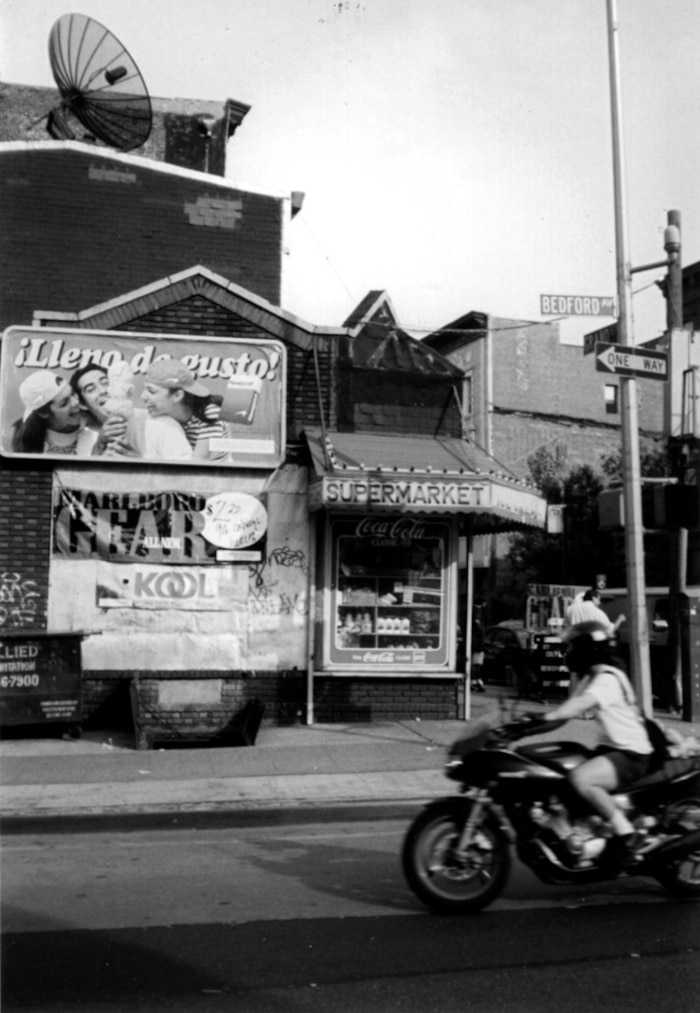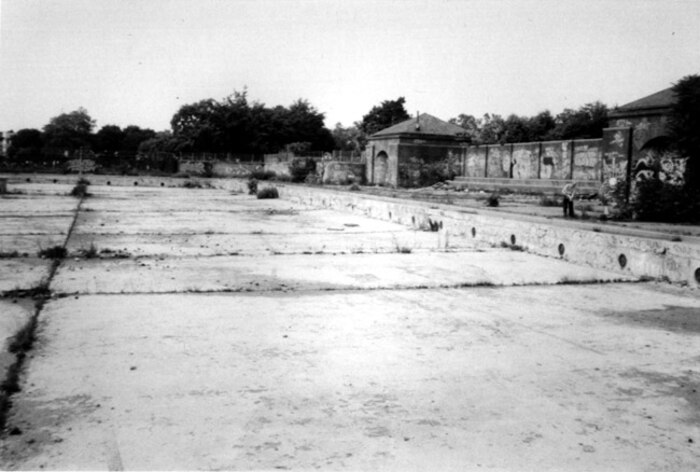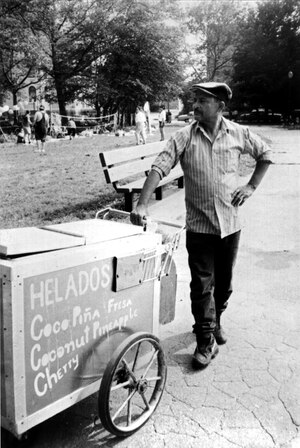New York Stories: Andrew “Monk One” Mason
A DJ discovers art and chaos in early ’90s Williamsburg.
“Williamsburg?” my coworker snorted.
It was 1992 and we were misting lettuce at an East Village grocery store. I had asked her opinion on the Brooklyn neighborhood just across the river. “I guess it’s okay if you don’t mind packs of wild dogs roaming the streets.” I thought she was joking, but I soon discovered that feral canines were only one of the charming aspects of what would become my new home.
A year out of college, I was living on Ludlow Street, sharing a small apartment with a friend who usually wasn’t there. There was a bar below us (Max Fish), a good restaurant on the corner (El Sombrero), a bodega across the street (La Esperanza) and a rotating assortment of junkies who congregated in our hallway due to the business activities of one of the building residents. After a while, I wanted a bigger place and was tired of stepping over passed-out Lou Reed wannabes. Chinatown seemed interesting and there were Alphabet City squats available, but nothing was really right. Then a friend convinced me to come out to Brooklyn with him to look around this place called Williamsburg.

It seemed like another world, though there was literally a bridge directly linking the two neighborhoods. Playing in a couple of bands, with my job and all my friends within a few block radius, I was wary of moving so far away from all the action. But real estate conquers all in this city, so we bravely sailed off the edge of the world, taking the L train past First Avenue and under the river to the then-foreboding Planet of Brooklyn.
He was planning to ask $1000 a month for the whole building, a two-story affair with a fenced-in backyard accessible to the street.
Our method of scouting for a rental was to walk around and pound on likely doors, asking if anything was open in the building. At one spot, a harried looking man speckled in paint opened the door. It was his house, and yes, he was getting ready to rent it but he wasn’t finished renovating. There’d been a fire, you see. He was planning to ask $1000 a month for the whole building, a two-story affair with a fenced-in backyard accessible to the street. This was way out of our budget, but the place was huge. My girlfriend, who’d tagged along, piped up. “We’ll give you $900 a month and move in now. We’ll finish the work.” The guy blinked, shrugged and told us we had a deal.
We occupied the place immediately, turning the fire-scarred downstairs (formerly a butcher shop) into a rehearsal space and art studio, and splitting the upstairs into bedrooms. With four of us living in the building, the math worked out to a little over $200 per month each on the corner of Havemeyer and North 8th Street.
The daytime center of Williamsburg life at that time was a little place on Bedford Avenue called the L Café, named after the subway line that stopped a block away. Ground zero of the early hipster influx, it was the only place to get such first-world necessities as a bagel with tofu cream cheese or a latté, a place where loft-share and bandmate-wanted fliers filled the walls. After dark, there was a decent bar a few blocks down with the horrible name Mugs, and several other drinking establishments that dealt cheap rye and Budweiser to old-guy lushes.
The train service was spotty and often surreally deserted, while the Williamsburg Bridge also provided a convenient ten-minute bike ride to the Lower East Side. It was a strange and wonderful netherworld suspended between Manhattan and Brooklyn, with cars and trucks obliviously rushing by as graffiti writers, junkies and random mischief-makers existed unmolested by police. I recalled how Sonny Rollins used to practice saxophone alone on that very catwalk and began scrawling the names of jazz greats next to all the other tags on the bridge, my own contribution to the glorious decay.
It was our secret society, scorned by the few outsiders who even knew about it.
Visible from the bridge at the end of Metropolitan Avenue was a giant abandoned warehouse known as the Mustard Factory. There were parties being thrown there, amazing art happenings that incorporated all varieties of sensory experience, bizarre light shows, freaky sculpture installations and multiple rooms of varied music. It was what I imagined Andy Warhol’s Factory had been like. It was our secret society, scorned by the few outsiders who even knew about it.
The waterfront itself was a playground of burned-out buildings and wasted freight-train cars. There were people who lived down there, members of a fringe society whose lives could be construed as art. They could’ve just as easily been considered mentally disturbed and homeless. It was bizarre to sit out there on a summer evening drinking a beer, gazing at the frenzy of Manhattan, while next to you somebody was using discarded toys and rubbish to construct a domicile reminiscent of Lee Perry’s Black Ark.

On weekends McCarren Park swelled with the Polish and Dominican families who had colonized the neighborhood 20 years earlier. Nearby was an enormous old pool – bone dry, weed-choked, and scattered with trash and years of accumulated graffiti. We would sneak in through the holes in the fence surrounding it and walk around like lunar explorers in the vast empty space, mentally time-traveling to the days when it was filled with water and screaming kids.
No one really cared about the neighborhood, so you could basically do anything: write your little tag all over the place, pay next to nothing for rent, throw wild parties in vacant buildings. I was often asked to DJ these affairs, for the simple reason that I was the local guy with turntables and a lot of records. These events would take place in cavernous lofts specially decorated for the night; everybody I knew in the neighborhood would be there. One night featured performances by trapeze artists swinging over people’s heads in a hollowed-out warehouse while I played music by Horace Silver and Bad Brains, A Tribe Called Quest and Marshall Jefferson.
Wild dogs in the streets were replaced by roving partiers hitting the rows of bars that sprang up like weeds.
By the late ’90s, things were beginning to change. The anarchic atmosphere was morphing into a controlled frenzy, as a critical mass of transplants filled the Northside, opening record stores, bars and bookshops. I was DJing more and more, to the detriment of my band activities. On the advice of a friend who said I needed a “cool” DJ name, I started putting one of my old jazz graffiti tags on tapes: Monk.
My time in the neighborhood was drawing to a close. Though I continued DJing weekly at Black Betty on Metropolitan, I had moved on, deeper into Brooklyn. My old house was sold to the church next door and became a convent. The secret was out: Williamsburg had become self-sufficient and the raucous era of the 2000s was starting. Wild dogs in the streets were replaced by roving partiers hitting the rows of bars that sprang up like weeds. They were the new arrivals, having a go with their own adventures.
A version of this article appeared in The Daily Note, a free daily newspaper distributed in New York during the 2013 Red Bull Music Academy.


